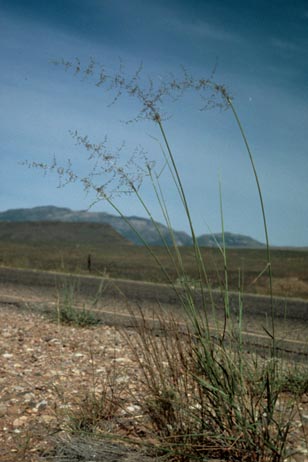Mesa Dropseed

Common Name(s):
Mesa Dropseed
Scientific Name:
Sporobolus flexuosus (Thrub. ex Vasey) Rydb.
Scientific Name Synonyms:
None known ()
Symbol:
SPFL2
Description:
Life Span: Perennial
Origin: Native
Season: Warm
Growth Characteristics: Mesa dropseed is a 12 – 40 inch tall, coarse-rooted, short-lived (4-5 years) perennial bunchgrass, which can sometimes grow as an annual. It reproduces from seeds that fall from the parent plant and can be wind blown. Development is quick during periods of adequate moisture and high night temperatures, especially when soil water becomes available below 4 inches. New stems appear in March and flowering starts 4 to 5 days after seedhead elongation begins. Mesa dropseed blooms from September to November.
Seedhead: The seedhead is an open, oblong panicle, 4–12 inches long. It has 1 floret producing 1 small seed per spikelet. The seeds have a hard seed coat that must be punctured before good germination occurs.
Leaves: Its leaf blades are flat or folded, becoming V-shaped toward the long-tapered tips and are less than 1/8 inch wide and up to 8 inches long. The leaf sheaths are densely long-hairy at the top and often have a fringe of hair along the margins. The ligules are a dense ring of short hairs.
Stems: >Long new stems or tillers originate from basal buds below the ground level and occasionally from a bud at an elevated node.
Ecological Adaptions:
Mesa dropseed occurs throughout Southern Utah. It is found mainly in dry areas with mean annual precipitation of 12 inches (300 mm) or less; it can survive in areas with as little as 6 to 7 inches (150-180 mm) mean annual precipitation. It greens up during the spring and again in late fall if moisture is adequate. During periods of drought, Mesa dropseed goes into a dormant stage. New seedlings establish in open areas and under shrubs.
Soils: It occurs on well-drained sand, sandy loams, loamy sands and gravelly soils.
Associated Species: Honey mesquite, broom snakeweed, black grama, soaptree yucca, spike dropseed, fourwing saltbush, creosotebush, mormon tea, frosted mint, Indian ricegrass, sand sagebrush, indigobush, rough mulesears, and blackbrush.
Uses and Management:
Mesa dropseed provides valuable forage for cattle throughout the year. Use is heaviest during the late spring and summer when the plant is actively growing and foliage is highly digestible. . Black-tailed jackrabbits and pronghorns also forage on it. It is valuable for stabilizing loose, sandy soils.
Native Americans used mesa dropseed seeds as food.

